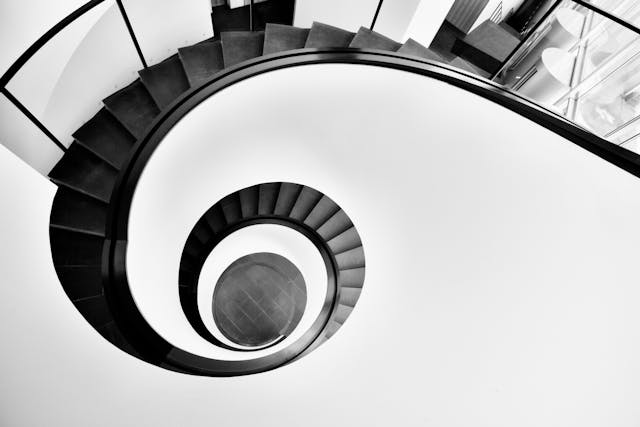In
Arts
The Architecture of Curved Stairs: A Dance of Form and Function
31 Oct, 2024

Stairs are more than just a means of moving between levels; they are architectural elements that can define the character of a space. Among the various designs, curved stairs stand out as a captivating fusion of form and function, seamlessly blending aesthetics with usability.
Curved stairs, often referred to as spiral stairs, introduce a sense of elegance and fluidity in architectural design. These staircases can transform ordinary spaces into extraordinary ones, creating visual interest and inviting movement. They are commonly used in both residential and commercial settings, offering an alternative to traditional straight stairs.
"Curved stairs are a testament to the creativity of architects, showcasing how a simple structural element can be transformed into an eye-catching focal point."From a practical perspective, curved stairs are space-efficient. Their design allows for a compact footprint, making them ideal for smaller homes or areas where space is limited. The curvature can also guide the flow of movement, directing users in a way that feels natural and intuitive.
However, the construction of curved stairs requires careful planning and expertise. The curvature must be precisely calculated to ensure safety and comfort for users. Additionally, the choice of materials plays a crucial role in the overall aesthetic. Whether constructed from wood, metal, or concrete, the finish can significantly impact the staircase's final appearance and integration within the surrounding environment.
Architects and designers often use curved stairs to make a bold statement. A grand spiral staircase can become the centerpiece of an entryway, while a subtle curve can enhance a minimalist design. The interplay of light and shadow on a well-designed curved staircase can create dynamic visual effects, further emphasizing its architectural beauty.
In conclusion, curved stairs represent a harmonious balance between form and function. They serve as a reminder that even the most utilitarian elements of architecture can be transformed into works of art, enriching our built environment and enhancing the experience of those who inhabit it.
Share:
Tags:
Arts
Comments(1)
Jane Smith
Ut enim ad minim veniam, quis nostrud exercitation ullamco laboris nisi ut aliquip ex ea commodo consequat
01 Nov, 2024 at 12:16 am
Reply To Jane Smith's Comment
Your email address will not be published. To leave a reply, fill all the required fields marked by *.
Leave A Reply
Your email address will not be published. To leave a reply, fill all the required fields marked by *.
Connect & Follow
Recent posts
-
The Perfect Pair: Burgers and...
01 Nov, 20242 comments -
The Morning Coffee Ritual: A...
01 Nov, 20241 comments -
A Mother’s Love: The Unseen...
01 Nov, 20243 comments -
Muffins and Coffee: The Perfect...
31 Oct, 20243 comments -
Coffee with Friends: The Perfect...
31 Oct, 20242 comments
Recent comments
- Bob Brown on Coffee with Friends: The Perfect Blend of Laughter and Connection
- Bob Brown on A Mother’s Love: The Unseen Work of Nurturing a Child
- John Doe on A Mother’s Love: The Unseen Work of Nurturing a Child
- John Doe on Top 5 Wellness Retreats in Bali to Rejuvenate Your Soul
- Jane Smith on The Morning Coffee Ritual: A Moment of Peace to Start the Day
Newsletter
Subscribe to my newsletter